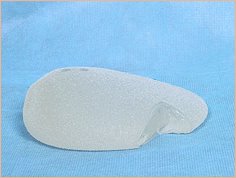
A few weeks back I promised to continue discussing some of the evolution in contemporary breast reconstruction. Most of that post had to do with past. This one's about the future. The future is the cohesive gel implant with or without a latissimus flap. This is for a couple reasons.
1. As I mentioned earlier, no one is going to subsidize the more labor-intensive reconstructions (ie. TRAM flaps, Free TRAMS, and the various perforator flaps - DIEP,SIEP,Ruben flaps,etc..)
2. The form-stable cohesive gels can look great with very little work, even in patients with thin skin flaps following mastectomy
Seen above is a cut section of the Inamed 410, a textured and anatomic-shaped implant that's fairly far along in the FDA approval process. It uses a silicone gel filler that's cross-linked much more then the traditional gel implants. This gives it the "gummy-bear" feel that patients have described it as.When the shell is cut or ruptures, the filler goes nowhere. This completely eliminates the migratory silicone gel that can cause some local issues in the breast or enlarged axillary lymph nodes. The safety data coming in on the 410 style blows away the currently FDA approved saline and silicone implants already sold. (NOTE: Mentor Corp. also makes a high-cohesive gel, the CPG, which is slightly behind Inamed's 410 in the approval process)
It's been used continuously since 1994 in Europe, and is the most popular style of implant for both reconstructive and cosmetic breast surgery in the world. Surgeons in other countries are amazed at the fact that the United States is still debating about 30 year old implant designs while they've already moved beyond that.
An excellent summary of the 410 cohesive can be found here






5 comments:
Hey,
Love your site. I'll definately be following it.
Kyle
What about cohesive gels and the irradiated patient
There should be no new consideration specifically with the gels in the radiated patient. You may get less capsular contracture with a Inamed 410-style implant from both its textured surface and from the counter-force implied upon the skin flaps by the rigidity of the cohesive gel.
Ideally you would perform a delayed reconstruction if you expect post-mastectomy radiation. The addition of a latissimus flap over an expander-implant reconstruction to bring in non-radiated skin to the lower breast pole can provide exellent results.
I am waiting for the FDA approval to attempt a 3rd bilat reconstruction s/p skin sparing mastectomy at age 38. I have such a thin chest wall that anykind of implant I get put in gets significant ptosis, creases and ripples. Are any surgeons using the new 4th generations cohesive gels in addition to alloderm pocket reinforcement that you are aware of?
In re. to your query re. the cohesive gels in thin chested patients....
My mentor, Dr. Pat Maxwell in Nashville,TN will use that combination of the Inamed 410 implant with Alloderm overlays to "hide" it better. There are VERY few surgeons currently able to use the 410's as the clinical trials are mostly closed. I expect that to change by next year given the overwhelming safety data presented to the FDA.
If you really have difficult breasts like you described I would strongly reccomend that you considering trying to go see Dr. Maxwell in Nashville. He is arguably the #1 guy in the world for revisional breast surgery. We had patients flying in from Doctors all over when I was his fellow (even a number from Dr. Rob Rey of Dr. 90210 fame).Dr. Maxwell's office # is 615-284-8200
Another world-class breast reonctructive surgeon to consider (and also a former fellow of Dr. Maxwell) is Dennis Hammond in Grand Rapids, Michigan. Dennis is a big proponent of using latissimus muscle flaps for extra coverage which may be something you require.
Post a Comment